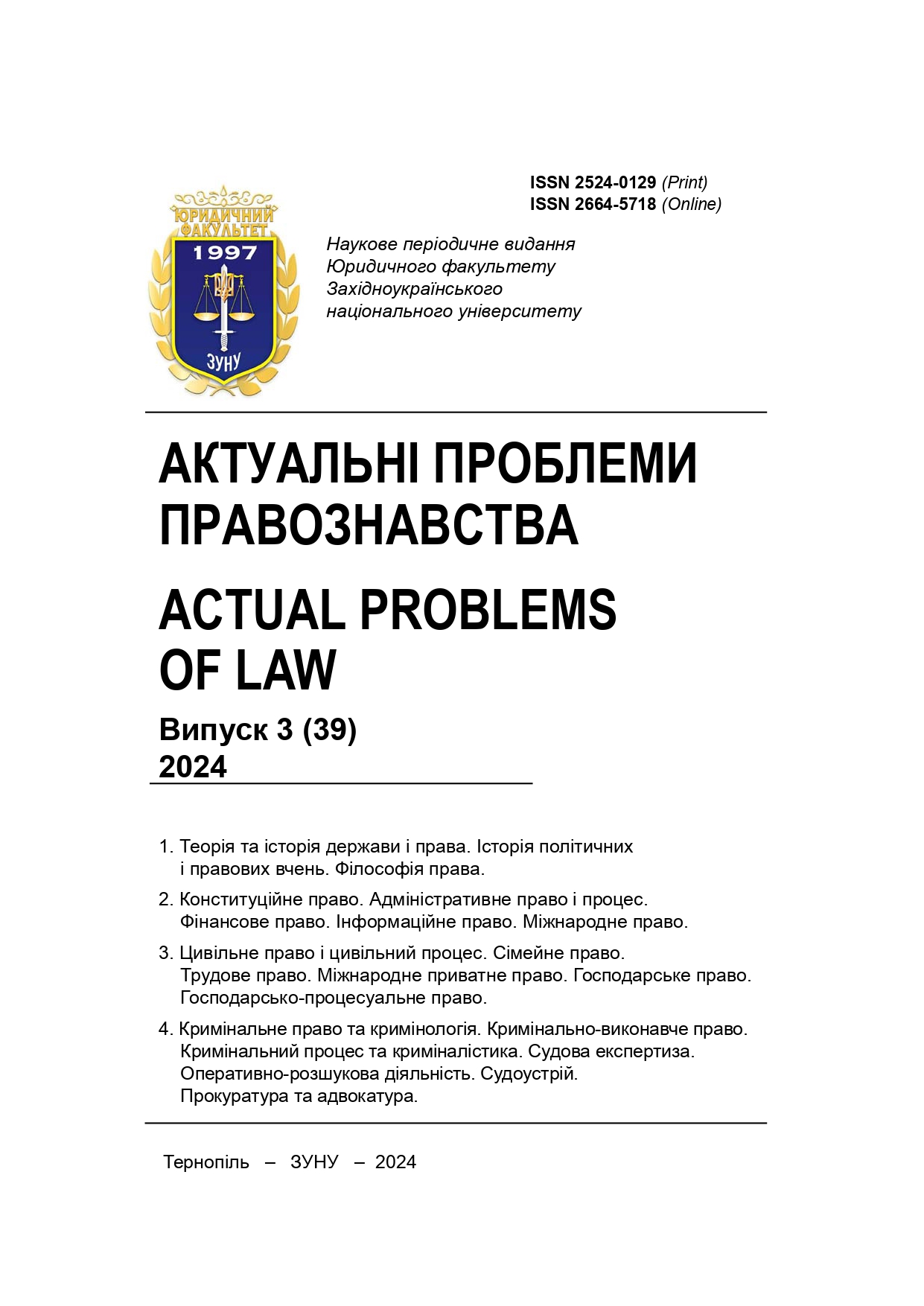Structure and Powers of the Parliament of Kazakhstan in the Context of the Separation of Powers
DOI:
https://doi.org/10.35774/app2024.03.110Keywords:
parliament, parliamentarism, legislative power, bicameral parliament, unicameral parliament, state structure, system of checks and balances, Mazhilis, Senate, executive power, powers, controlAbstract
Relevance of the research topic. The study of the structure and powers of the Parliament of the Republic of Kazakhstan is relevant in the context of the transformations occurring in post-Soviet political systems. The current realities in Kazakhstan, characterized by a high level of centralization of power, necessitate a critical analysis of the Parliament's role in ensuring a balance between branches of government and representing citizens' interests. Particularly important is the interaction between the Parliament and the executive branch, including its oversight functions and legislative powers. The bicameral structure of the Parliament presents challenges for the effectiveness of the legislative process, as differing powers between the Mazhilis and the Senate may complicate oversight of executive bodies. Furthermore, Kazakhstan is undergoing a period of political change aimed at modernizing its system, highlighting the importance of evaluating the effectiveness of parliamentary institutions. In light of global challenges such as national security and economic development, the Parliament plays a key role in shaping legal decisions that influence policy. A comparative analysis of the political systems of post-Soviet countries, particularly Kazakhstan, can be beneficial for the reform of the Ukrainian political system.
The purpose of this study is to analyze the structure and powers of the Parliament of Kazakhstan, as well as to investigate its role within the system of checks and balances, particularly in its interaction with the executive branch.
Results of the research. The article examines the formation and development of the Parliament of the Republic of Kazakhstan following its independence in 1991, as well as the evolution of the bicameral system established in the 1995 Constitution and its impact on the legislative process and political stability. It explores the functional differences between the Mazhilis, which represents national interests, and the Senate, which advocates for regional interests. The analysis addresses the limitations on parliamentary powers, particularly the influence of the executive branch and the president on legislative processes. Special attention is given to issues of democratization and potential political reforms aimed at redistributing powers between the parliament and the executive branch. The article also outlines the problems of insufficient transparency in Senate elections and limited parliamentary oversight. It notes that recent political transformations present opportunities for strengthening the parliamentary system by enhancing the effectiveness of representative functions and the legislative process. The specific characteristics of the Kazakh parliament are highlighted, particularly its role in the system of checks and balances, emphasizing the weakness of parliamentarism as demonstrated by limited oversight of the executive branch. It concludes that while recent political reforms may indicate a reduction in presidential powers and an enhancement of parliamentary functions, implementing these changes will require a balance of power between the parliament and the executive to ensure the effective development of democratic processes.
References
Kuzio, T. (2012). Twenty years as an independent state: Ukraine’s ten logical inconsistencies. Communist and Post-Communist Studies, 45(3-4), 429-438 [in English]
Constitution of the Republic of Kazakhstan. Retrieved from https://www.akorda.kz/en/constitution-of-the-republic-of-kazakhstan-50912 [in English]
Knox, C. (2008). Kazakhstan: Modernizing government in the context of political inertia. International Review of Administrative Sciences, 74(3), 477–496 [in English]
Dzhunusova, Z. (1998). Kazakstan’s Political Transformation since 1991. Nationalities Papers, 26(3), 545-555. doi:10.1080/00905999808408582 [in English].
Machelski, Z. (202). Models of bicameral parliaments. A comparative approach. Models of bicameral parliaments. A comparative approach. Wrocławskie Studia Politologiczne, 13. Retrieved from https://wuwr.pl/wrsp/article/view/11567 [in English]
Lialiuk, O. Yu. & Bilous, D. Ye. (2023). Perspektyvy vprovadzhennia dvopalatnoi struktury parlamentu v Ukraini: mizhnarodnyi dosvid ta suchasni tendentsii [Prospects for Implementing a Bicameral Parliamentary Structure in Ukraine: International Experience and Current Trends]. Prykarpatskyi yurydychnyi visnyk - Precarpatian Legal Review, 5 (52), 21-26. Retrieved from http://pjv.nuoua.od.ua/v5_2023/4.pdf [in Ukrinian]
Natsionalni parlamenty Yevropeiskoho Soiuzu [National parliaments of the European Union]. Retrieved from https://uk.wikipedia.org/wiki/%D0%9D%D0%B0%D1%86%D1%96%D0%BE%D0%BD%D0%B0%D0%BB%D1%8C%D0%BD%D1%96_%D0%BF%D0%B0%D1%80%D0%BB%D0%B0%D0%BC%D0%B5%D0%BD%D1%82%D0%B8_%D0%84%D0%B2%D1%80%D0%BE%D0%BF%D0%B5%D0%B9%D1%81%D1%8C%D0%BA%D0%BE%D0%B3%D0%BE_%D0%A1%D0%BE%D1%8E%D0%B7%D1%83 [in Ukrinian]
Irkliienko, A. I. (2020). Dvopalatnyi parlament v umovakh formuvannia konstytutsiinoi demokratii [A bicameral parliament in the context of constitutional democracy]. Chasopys Kyivskoho universytetu prava - Journal of the Kyiv University of Law, 1, 136-139. Retrieved from https://chasprava.com.ua/index.php/journal/article/download/272/257/ [in Ukrinian]
On the Parliament of the Republic of Kazakhstan and the status of its deputies: Constitutional Law of the Republic of Kazakhstan No 2529 dated October 16, 1995. Retrieved from https://adilet.zan.kz/eng/docs/Z950002529 [in English]
Bowyer, A. Clive. (2008). Parliament and Political Parties in Kazakhstan. Retrived from Central Asia-Caucasus Institute and Silk Road Studies. Retrieved from https://www.silkroadstudies.org/resources/pdf/SilkRoadPapers/2008_05_ SRP_Bowyer_Parliament-Kazakhstan.pdf [in English]
Khairmukhanmedov, N. (2017). Structural characteristics and problems of the Presidential System in the Republic of Kazakhstan. International Journal of Social Sciences and Education Research, 3(5 S), 1432-1451. https://doi.org/10.24289/ijsser.312098 [in English]
Mukhamedzhanov, O. (2019). Formation of parliamentarism in Kazakhstan: current agenda. Journal of Legal, Ethical and Regulatory Issues, 22 (4), 1-16. Retrieved from https://www.abacademies.org/articles/formation-of-parliamentarism-in-kazakhstan-current-agenda-8545.html [in English]
Nash parlamentaryzm: doslidzhuiemo, rozumiiemo, vplyvaiemo [Our parliamentarism: exploring, understanding, influencing]. Metodychnyi posibnyk z parlamentskoi prosvity dlia roboty z ditmy i moloddiu v systemi zahalnoi serednoi ta pozashkilnoi osvity. Kyiv. 2023. Retrieved from https://edudevelop.org.ua/images/files/Posibnik_Nash_Parlament_2023_S.pdf [in Ukrinian]
Yan, H. T. (2017). Comparing democratic performance of semi-presidential regimes in the post-communist region: Omnipotent presidents and media control. Communist and Post-Communist Studies, 50(4), 263-275. Retrieved from https://ouci.dntb.gov.ua/en/works/4YkO8L39/ [in English]





